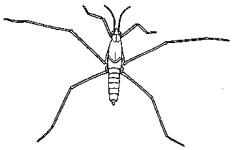   Family: Gerridae
Species: Gerris argentatus
Family: Gerridae
Species: Gerris argentatusThe water strider lives on ponds and small streams, and can run across the surface of the water. Its belly is covered with water-repellent hair. Like all insects, it has a three-part body (head, thorax and abdomen), six legs, and two antennae. It has a long, narrow body. Some water striders have wings, and most of these bugs are about a centimetre long. The water strider's long middle legs move it across the surface of the water like paddles. The hind legs are used to steer, and also act as brakes. The short front legs are used to catch prey. Water striders eat small insects that fall on the water's surface, or larvae that live just below the surface. Water striders are very sensitive to motion and vibrations, and use these to find prey, which they catch and suck dry. Water striders do not bite people, and because they cannot detect motion above or below the water's surface, are easy prey themselves for frogs, fish, and birds. How is it that water striders can walk on water without ever falling in or getting wet? The answer has to do with surface tension. This force between the molecules of the surface acts like a 'skin', and tends to repel solids. Very light objects are supported by this force, and the water strider has a very small mass. The water strider also has feet coated with a surface that repels water, much like waxed paper. The result is that the tiny insect barely makes contact with the surface of the water with the tips of its feet, and where it does make contact, it doesn't break through the surface. If the hairs on the legs of a water strider become wet due to oil or detergent on the water surface, surface tension is broken and the water strider will sink. With very little contact between its feet and the water, there should be very little friction. Without much friction, the water strider shouldn't be able to move on the slippery surface of the water. How does it propel itself? The key is the small dimples that the water strider's legs make in the surface. They create drag, and by pushing the dimples backward, the water strider can move forward. |